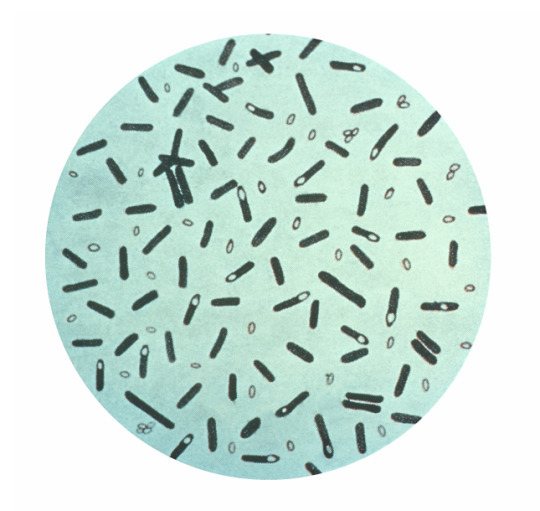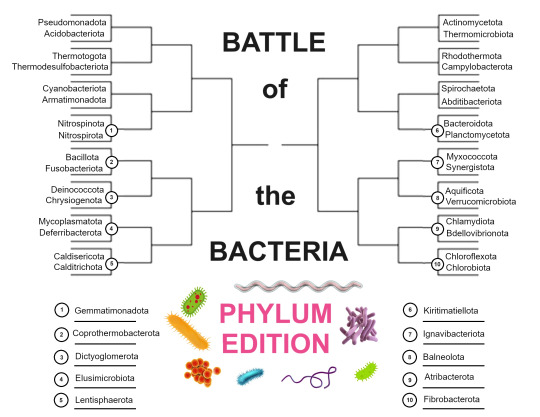#bacillota
Explore tagged Tumblr posts
Text
Bacillota vs. Fusobacteriota


Bacillota propaganda here
Fusobacteriota propaganda here
36 notes
·
View notes
Text
#aFactADay2024
#1427: they say your microbiome tells you about yourself, but your microbiome can also tell you about others: people you interact with leave their skin microbiome on you. it's uncertain how long these stick around, but with people you constantly interact with (eg in the same household) it means that you basically share your skin microbiome. other microbiota, for example your gut, are also (somehow) likelier to be much similar between people living together. you also share your microbiome with your pets, particularly on your skin. in fact, some suppose that living with a dog can improve your gut microbiome because dog owners have a completely different ratio of the types of bacteria making up the microbiota. for example, the Bacillota/Bacteroidota ratio (no i don't know what that means either) was significantly lower in dog owners, which has been historically correlated with lower obesity. i think.
2 notes
·
View notes
Text
Applied Microbiology, Vol. 4, Pages 1268-1282: Addition of Chicken Litter Compost Changes Bacteriobiome in Fallow Soil
Composting is an environmentally friendly process, turning animal waste into fertilizer. Chicken litter compost (CLC) improves soil properties, increasing crop yields. However, the CLC effect on the soil microbiome is understudied. This study aimed to compare bacteriobiome diversity in fallow arable Chernozem with and without CLC addition in a field experiment in the Novosibirsk region, Russia, using 16S #rRNA gene metabarcoding. Pseudomonadota, Actinomycetota and Acidobacteriota were the most OTU-rich phyla, together accounting for >50% of the total number of sequence reads. CLC-related shifts in the bacteriobiome structure occurred at all taxonomic levels: the Bacillota abundance was 10-fold increased due to increased Bacilli, both being indicator taxa for the CLC-soil. The main Actinomycetota classes were the indicators for the CLC-soil (Actinobacteria) and no-CLC soil (Thermoleophilia, represented Gaiella). Both Bacillota and Actinomycetota phyla were the ultimate constituents of the CLC added, persisting in the soil for five months of fallowing. The no-CLC soil indicator phyla were Acidobacteriota (represented by Acidobacteria_Group3) and Verrucomicrobiota. Future metabarcoding studies of chicken litter application in agricultural soils, including cropped studies, should address the soil microbiome at the species/strain levels in more detail, as well as how it is affected by specific crops, preferably accompanied by a direct methodology revealing the microbiota functions. https://www.mdpi.com/2673-8007/4/3/87?utm_source=dlvr.it&utm_medium=tumblr
0 notes
Text
prompted by finding out that like a year ago they published valid names for bacterial kingdoms according to newly created rules for that and they're all [genus][suffix] when descriptive names for these taxa already existed (eg. terrabacteria (named as such because of terrestrial adaptations that their common ancestor is inferred to have had) is now kingdom Bacillati which is just Bacillus+ati, IE, it's [genus][suffix]). Back in 2021 many bacterial phyla were renamed the same way too, like Firmicutes being renamed to Bacillota. These are less distinct and less descriptive names and i like the old ones better.
i think taxonomic classes and above deserve to all have names more unique than [type genus][suffix]
20 notes
·
View notes
Text
Who was gonna tell me that science changed the name from Firmicutes to Bacillota!!!???
I hate it here 😭
0 notes
Photo

~ Bacillota ~
“Do not ask God for anything,” the middle sister said, sitting on her seat like she might spring from it and fly, like a word and not a woman sat there. A sharp and sudden word like ‘no,’ or ‘do,’ or ‘go,’ or ‘shoo!’ She said nothing after but did not blink.
“Pray if you want to,” the older sister spoke, and she was at her sink standing. Standing at her sink, rubbing dishes with her hands because her hands were cold and the water warm. She could ask God for anything. And she did.
The house hushed and paper peeled. Their sister – their younger sister – was a smile on their walls. Only. And her name tossed in the air, only like petals fall and fade. They looked to their Easter portrait when Christ was raised on Mother’s yard when they still went to church but never wondered about God.
#poetry#poetry and writing#writing#poetscorner#poetsoftumbr#photography#3 am thoughts#pretentiousilliterate
1 note
·
View note
Text
Bacillota
Group: Terrabacteria
Gram-stain: Positive (mostly)
Etymology: For Bacillus subtilis. From the Latin "baculus", meaning "stick", for the numerous rod-shaped species in this phylum.
About: Bacillota is a phylum that packs a punch: it contains several deadly infectious diseases, capable of forming durable endospores. These spores are contained in a sort of protein capsule, which protects it from the immune system of the host organism. Bacillota is a long-studied phylum: the species Bacillus subtilis was isolated and described in detail in 1872, but was probably first isolated long before that (1832).
Among the ranks of Bacillota are anthrax (Bacillus anthracis), MRSA (methicillin-resistant Staphylococcus aureus), and botulism (Clostridium botulinum). In addition to being an infectious disease, botulism is famous for producing botulinum toxin, the deadliest poison and neurotoxin known to man (based on the smallest lethal dose). This toxin is colloquially known as "botox", and as you may have guessed, is used in numerous medical procedures (not exclusively cosmetic).

The above picture is botulism, with numerous endospores. I like this image because it shows various stages of endospore development, and you can see what they look like while still inside the cell (here the botulism bacteria are dark, the endospores are light).
Another impressive species of Bacillota is candidatus Desulforudis audaxviator, famous for being an ecosystem of one: they are the sole organisms in their habitat, nearly 3 km beneath the surface of the earth. D. audaxviator is the only known organism capable of sustaining a single-species ecosystem. This ecosystem is one of the few without sunlight as part of the food chain: D. audaxviator are chemotrophs whose nutrients are replenished in the environment by radioactive decay.
12 notes
·
View notes
Text
They go to a dark field (since perception of light at microscopic level is bad) filled with a primordial soup, so they can mitosis forever and ever.
Except the Bacillotas, they don’t deserve bacteria heaven, they are dropped in a pit of soap that kills 99,99% of bacteria, but they are already dead, so their suffering is eternal.
How many bacteria do I kill a day?
23K notes
·
View notes
Text
Phylum Bracket Announcement!

42 bacterial phyla, from two sources: Oren & Garrity (2021), and the list of recognized bacterial phyla under the ICNP as of February 2024. The Oren & Garrity list is more expansive, as it includes bacterial phyla that have been well studied, but not cultivated in the lab, while the ICNP restricts itself to bacteria that have been successfully cultured. 36 phyla were on both lists, 4 were exclusive to Oren & Garrity, and 2 were exclusive to the ICNP. Two phyla from the Oren & Garrity list were excluded for not being bacteria, as the list was of prokaryotic phyla generally.
The first round will be between 32 of the phyla, while ten sit out. Then the second round, which will be called round 1.5, will pair ten of the winners from the first round against those ten. Thus, after round 1.5, there will be 16 bacterial phyla remaining, and the tournament proceeds as is standard from there.
Here is a list of the phyla, organized (roughly) by clade and superphylum. Clades/superphyla are in bold and phylum names are in italics for clarity.
Terrabacteria
Abditibacteriota
Actinomycetota
Armatimonadota
Bacillota
Chloroflexota
Cyanobacteria
Mycoplasmatota
Thermomicrobiota
Hydrobacteria
Elusimicrobiota
Spirochaetota
Proteobacteria
Acidobacteriota
Aquificota
Bdellovibrionota
Campylobacterota
Chrysiogenota
Deferribacterota
Myxococcota
Nitrospinota
Nitrospirota
Pseudomonadota
Thermodesulfobacteriota
PVC Group
Chlamydiota
Lentisphaerota
Kirimatiellota
Planctomycetota
Verrucomicrobiota
FCB Group
Bacteroidota
Balneolota
Chlorobiota
Fibrobacterota
Gemmatimonadota
Ignavibacteriota
Rhodothermota
Thermotogida
Synergistetes
Atribacterota
Synergistota
Thermocalda
Caldisericota
Calditrichota
Coprothermobacterota
Dictyoglomerota
Thermotogota
Other
Deinococcota
Fusobacteriota
Propaganda is still underway, but look out for an announcement of the first battles soon! I am planning to do round 1 in two parts over two weeks, with 8 battles in each week. Get ready: the girls are fighting !!!
66 notes
·
View notes
Text
First part is officially over! Congratulations to Pseudomonadota, Thermotogota, Cyanobacteriota, Nitrospirota, Bacillota, Deinococcota, Mycoplasmatota and Caldisericota, who will all be moving on to round 2 (or 1.5)! Condolences to Acidobacteriota, Thermodesulfobacteriota, Armatimonadota, Nitrospinota, Fusobacteriota, Chrysiogenota, Deferribacterota, and Calditrichota: we still love you!
Partially-updated bracket:

Round 1, part 2 should begin tomorrow. Get excited!
16 notes
·
View notes
Text
Round 1 is Complete!

In the second part of the first round, Actinomycetota, Rhodothermota, Spirochaetota, Planctomycetota, Myxococcota, Verrucomicrobiota, Bdellovibrionota and Chloroflexota were victorious! We will be saying goodbye to Thermomicrobiota, Campylobacterota, Abditibacterota, Bacteroidota, Synergistota, Chlamydiota, and Chlorobiota.
The list of bacteria that will proceed to Round 2 will be determined after Round 1.5, which will consist of the following 10 battles!
Nitrospirota vs. Gemmatimonadota
Bacillota vs. Coprothermobacterota
Deinococcota vs. Dictyoglomerota
Mycoplasmatota va. Elusimicrobiota
Caldisericota vs. Lentisphaerota
Planctomycetota vs. Kiritimatiellota
Myxococcota vs. Ignavibacteriota
Verrucomicrobiota vs. Balneolota
Bdellovibrionota vs. Atribacterota
Chloroflexota vs. Fibrobacterota
I have a lot of propaganda left to write for the new bacteria in this round, so I expect it to be about a week before that round is ready.
THANK YOU all for voting! The most popular poll this round got over 200 votes, and I am so happy to see that kind of engagement over microbiology. I myself have learned SO MUCH about bacteria through this project and hope to learn more about the field afterwards... honestly this whole tumblr taxonomy community has been really inspiring!
THANK YOU as well to: @0ctogus! They proof-read basically ALL of the propaganda that hits your dash (with the exception of some early examples), and were generally super helpful as a source of quality-control and peer-review, from someone who has a much better knowledge of biology than I. It didn't feel right to finish this round off without mentioning their contributions!
And that concludes Round 1! See you all soon with more Bacteria Facts.
16 notes
·
View notes
Text
VOTE BACILLOTA!
Bacillota vs. Fusobacteriota


Bacillota propaganda here
Fusobacteriota propaganda here
#bacillota definitely has peptidoglycan btw#the confusion might be that their spores don't?#but regular vegetative cells do#bacteria showdown
36 notes
·
View notes
Text
As much as Fusobacteriota are interesting due to their relative taxonomic isolation and their role as a structural component of dental plaque (though I thought it was Strep mutans and Lactobacilli causing caries), Bacillota has it all... The deadliest bacterial toxin known to man in botulism, and a bacteria that lives miles under the earth's crust as an ecosystem of one sustained by radioactive decay from the earth's core? Come on
Bacillota vs. Fusobacteriota


Bacillota propaganda here
Fusobacteriota propaganda here
36 notes
·
View notes